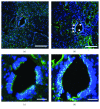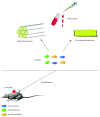Employing Endogenous NSCs to Promote Recovery of Spinal Cord Injury
- PMID: 31191666
- PMCID: PMC6525819
- DOI: 10.1155/2019/1958631
Employing Endogenous NSCs to Promote Recovery of Spinal Cord Injury
Abstract
Endogenous neural stem cells (NSCs) exist in the central canal of mammalian spinal cords. Under normal conditions, these NSCs remain quiescent and express FoxJ1. After spinal cord injury (SCI), the endogenous NSCs of a heterogeneous nature are activated and proliferate and migrate towards the lesion site and mainly differentiate into astrocytes to repair the injured tissue. In vitro, spinal cord NSCs are multipotent and can differentiate into neurons, astrocytes, and oligodendrocytes. The altered microenvironments after SCI play key roles on the fate determination of activated NSCs, especially on the neuronal specification potential. Studies show that the activated spinal cord NSCs can generate interneurons when transplanted into the adult hippocampus. In addition, the spinal cord NSCs exhibit low immunogenicity in a transplantation context, thus implicating a promising therapeutic potential on SCI recovery. Here, we summarize the characteristics of spinal cord NSCs, especially their properties after injury. With a better understanding of endogenous NSCs under normal and SCI conditions, we may be able to employ endogenous NSCs for SCI repair in the future.
Figures


Similar articles
-
Coaxial 3D printing of hierarchical structured hydrogel scaffolds for on-demand repair of spinal cord injury.Acta Biomater. 2023 Sep 15;168:400-415. doi: 10.1016/j.actbio.2023.07.020. Epub 2023 Jul 20. Acta Biomater. 2023. PMID: 37479156
-
Astrocytes migrate from human neural stem cell grafts and functionally integrate into the injured rat spinal cord.Exp Neurol. 2019 Apr;314:46-57. doi: 10.1016/j.expneurol.2019.01.006. Epub 2019 Jan 15. Exp Neurol. 2019. PMID: 30653967
-
Direct neuronal differentiation of neural stem cells for spinal cord injury repair.Stem Cells. 2021 Aug;39(8):1025-1032. doi: 10.1002/stem.3366. Epub 2021 Mar 5. Stem Cells. 2021. PMID: 33657255 Review.
-
Mash-1 modified neural stem cells transplantation promotes neural stem cells differentiation into neurons to further improve locomotor functional recovery in spinal cord injury rats.Gene. 2021 May 20;781:145528. doi: 10.1016/j.gene.2021.145528. Epub 2021 Feb 22. Gene. 2021. PMID: 33631250
-
Regulating Endogenous Neural Stem Cell Activation to Promote Spinal Cord Injury Repair.Cells. 2022 Mar 1;11(5):846. doi: 10.3390/cells11050846. Cells. 2022. PMID: 35269466 Free PMC article. Review.
Cited by
-
Pulsating Extremely Low-Frequency Electromagnetic Fields Influence Differentiation of Mouse Neural Stem Cells towards Astrocyte-like Phenotypes: In Vitro Pilot Study.Int J Mol Sci. 2024 Apr 4;25(7):4038. doi: 10.3390/ijms25074038. Int J Mol Sci. 2024. PMID: 38612847 Free PMC article.
-
Progression in translational research on spinal cord injury based on microenvironment imbalance.Bone Res. 2022 Apr 8;10(1):35. doi: 10.1038/s41413-022-00199-9. Bone Res. 2022. PMID: 35396505 Free PMC article. Review.
-
Stem Cell Therapies for Restorative Treatments of Central Nervous System Ischemia-Reperfusion Injury.Cell Mol Neurobiol. 2023 Mar;43(2):491-510. doi: 10.1007/s10571-022-01204-9. Epub 2022 Feb 7. Cell Mol Neurobiol. 2023. PMID: 35129759 Free PMC article. Review.
-
Transcriptomic analysis of α-synuclein knockdown after T3 spinal cord injury in rats.BMC Genomics. 2019 Nov 14;20(1):851. doi: 10.1186/s12864-019-6244-6. BMC Genomics. 2019. PMID: 31726970 Free PMC article.
-
Glycoprotein non-metastatic melanoma B interacts with epidermal growth factor receptor to regulate neural stem cell survival and differentiation.Open Med (Wars). 2023 Feb 14;18(1):20230639. doi: 10.1515/med-2023-0639. eCollection 2023. Open Med (Wars). 2023. PMID: 36820063 Free PMC article.
References
Publication types
LinkOut - more resources
Full Text Sources

